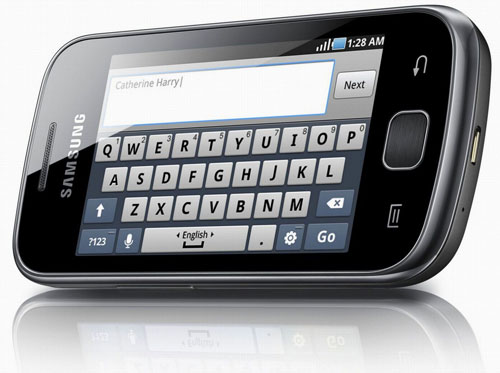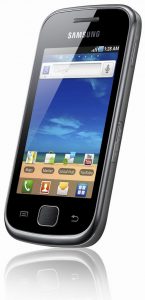
The Samsung Galaxy Gio (or GT-S5660) is a budget smartphone that’s compact and less feature-rich than a high-end device, but because it runs Google’s popular Android operating system it sacrifices little on the functionality front despite a diminutive price.
The Gio weighs just 102g and is fairly minimalist. There’s a power/lock button on the right-hand side, a volume switch on the left, a micro USB port on the bottom and a 3,5mm audio jack on top. Beneath the screen is a central “home” button, flanked by two capacitive-touch buttons, a menu/options button on the left and a back button on the right.
Out of the box, the Gio runs Android 2.2.1 (Froyo) and can be upgraded to Gingerbread with a little elbow grease — the official upgrade is due from Samsung soon. Even though the Gio has only an 800MHz Qualcomm processor, it feels responsive and smooth and its smaller screen no doubt helps on this front.
Screens are one of the most costly aspects of modern handsets — and the greatest drain on battery power. The Gio’s 3,2-inch capacitive-touch, 320×480-pixel TFT screen is smaller and has lower pixel density than many of its rivals, but with its 16m colours it still looks great. The smaller screen also means good battery life.

Samsung has also saved costs with the Gio’s camera. There’s only one of them, a 3,1-megapixel shooter on the rear that takes stills and QVGA video at 15 frames per second, and it’s nothing to write home about. But then, for the price, it’s not really fair to complain too much about it.
The Gio has all of the usual connectivity options you’d expect from a smartphone, and includes an accelerometer and built-in GPS. The former is particularly important as it’s very difficult to type on the tiny Qwerty keyboard in portrait mode. Fortunately, Samsung includes the option of using a traditional keypad keyboard with predictive text in portrait and Qwerty in landscape.
The GPS support is made all the more pleasing by the recent launch of Google Navigation in SA. Not only is the Gio a capable handset, but it’s now also a competent and compact navigation tool with a smaller price tag than some high-end standalone GPS devices.
One of the nicest things about the Gio is the inclusion of minor but appreciated features. For example, the Gio includes an FM receiver and support for a microSD card (up to 32GB), the slot for which is accessed by a cover on the right-hand side, rather than beneath the battery – which is both common and irksome.
On the whole, it’s hard not to be impressed with the Gio. It may not have all of the proverbial bells and whistles of its high-end contemporaries, but at R1 999 it’s also a third of the price of many of them.
We’re expecting to see many more budget smartphones from Samsung and its competitors in the months ahead. The Gio sets the benchmark pretty high for its price range and rival manufacturers are going to have to offer similarly specced devices if they’re to compete in what will be a closely contested segment of the market. — Craig Wilson, TechCentral
- Subscribe to our free daily newsletter
- Follow us on Twitter or on Facebook

